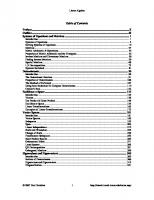Linear algebra [Rev. English ed] 0135367557, 9780135367551
Text: English, Russian (translation) In this volume in his exceptional series of translations of Russian mathematical te
287 13 2MB
English Pages 387 [399] Year 1971
Table of contents :
Contents
Chapter 1 DETERMINANTS
1.1. Number Fields
1.2. Problems of the Theory of Systems of Linear Equations
1.3. Determinants of Order n
1.4. Properties of Determinants
1.5. Cofactors and Minors
1.6. Practical Evaluation of Determinants
1.7. Cramer's Rule
1.8. Minors of Arbitrary Order. Laplace's Theorem
1.9. Linear Dependence between Columns
Problems
Chapter 2 LINEAR SPACES
2.1. Definitions
2.2. Linear Dependence
2.3. Bases, Components, Dimension
2.4. Subspaces
2.5. Linear Manifolds
2.6. Hyperplanes
2.7. Morphisms of Linear Spaces
Problems
Chapter 3 SYSTEMS OF LINEAR EQUATIONS
3.1. More on the Rank of a Matrix
3.2. Nontrivial Compatibility of a Homogeneous Linear System
3.3. The Compatibility Condition for a General Linear System
3.4. The General Solution of a Linear System
3.5. Geometric Properties of the Solution Space
3.6. Methods for Calculating the Rank of a Matrix
Problems
Chapter 4 LINEAR FUNCTIONS OF A VECTOR ARGUMENT
4.1. Linear Forms
4.2. Linear Operators
4.3. Sums and Products of Linear Operators
4.4. Corresponding Operations on Matrices
4.5. Further Properties of Matrix Multiplication
4.6. The Range and Null Space of a Linear Operator
4.7. Linear Operators Mapping a Space Kn into Itself
4.8. Invariant Subspaces
4.9. Eigenvectors and Eigenvalues
Problems
Chapter 5 COORDINATE TRANSFORMATIONS
5.1. Transformation to a New Basis
5.2. Consecutive Transformations
5.3. Transformation of the Components of a Vector
5.4. Transformation of the Coefficients of a Linear Form
5.5. Transformation of the Matrix of a Linear Operator
*5.6. Tensors
Problems
Chapter 6 THE CANONICAL FORM OF THE MATRIX OF A LINEAR OPERATOR
6.1. Canonical Form of the Matrix of a Nilpotent Operator
6.2. Algebras. The Algebra of Polynomials
6.3. Canonical Form of the Matrix of an Arbitrary Operator
6.4. Elementary Divisors
6.5. Further Implications
6.6. The Real Jordan Canonical Form
*6.7. Spectra, Jets and Polynomials
*6.8. Operator Functions and Their Matrices
Problems
Chapter 7 BILINEAR AND QUADRATIC FORMS
7.1. Bilinear Forms
7.2. Quadratic Forms
7.3. Reduction of a Quadratic Form to Canonical Form
7.4. The Canonical Basis of a Bilinear Form
7.5. Construction of a Canonical Basis by Jacobi's Method
7.6. Adjoint Linear Operators
7.7. Isomorphism of Spaces Equipped with a Bilinear Form
*7.8. Multilinear Forms
7.9. Bilinear and Quadratic Forms in a Real Space
Problems
Chapter 8 EUCLIDEAN SPACES
8.1. Introduction
8.2. Definition of a Euclidean Space
8.3. Basic Metric Concepts
8.4. Orthogonal Bases
8.5. Perpendiculars
8.6. The Orthogonalization Theorem
8.7. The Gram Determinant
8.8. Incompatible Systems and the Method of Least Squares
8.9. Adjoint Operators and Isometry
Problems
Chapter 9 UNITARY SPACES
9.1. Hermitian Forms
9.2. The Scalar Product in a Complex Space
9.3. Normal Operators
9.4. Applications to Operator Theory in Euclidean Space
Problems
Chapter 10 QUADRATIC FORMS IN EUCLIDEAN AND UNITARY SPACES
10.1. Basic Theorem on Quadratic Forms in a Euclidean Space
10.2. Extremal Properties of a Quadratic Form
10.3. Simultaneous Reduction of Two Quadratic Forms
10.4. Reduction of the General Equation of a Quadric Surface
10.5. Geometric Properties of a Quadric Surface
*10.6. Analysis of a Quadric Surface from Its General Equation
10.7. Hermitian Quadratic Forms
Problems
*Chapter 11 FINITE-DIMENSIONAL ALGEBRAS AND THEIR REPRESENTATIONS
11.1. More on Algebras
11.2. Representations of Abstract Algebras
11.3. Irreducible Representations and Schur's Lemma
11.4. Basic Types of Finite-Dimensional Algebras
11.5. The Left Regular Representation of a Simple Algebra
11.6. Structure of Simple Algebras
11.7. Structure of Semisimple Algebras
11.8. Representations of Simple and Semisimple Algebras
11.9. Some Further Results
Problems
*Appendix
CATEGORIES OF FINITE-DIMENSIONAL SPACES
A.1. Introduction
A.2. The Case of Complete Algebras
A.3. The Case of One-Dimensional Algebras
A.4. The Case of Simple Algebras
A.5. The Case of Complete Algebras of Diagonal Matrices
A.6. Categories and Direct Sums
HINTS AND ANSWERS
BIBLIOGRAPHY
INDEX
Contents
Chapter 1 DETERMINANTS
1.1. Number Fields
1.2. Problems of the Theory of Systems of Linear Equations
1.3. Determinants of Order n
1.4. Properties of Determinants
1.5. Cofactors and Minors
1.6. Practical Evaluation of Determinants
1.7. Cramer's Rule
1.8. Minors of Arbitrary Order. Laplace's Theorem
1.9. Linear Dependence between Columns
Problems
Chapter 2 LINEAR SPACES
2.1. Definitions
2.2. Linear Dependence
2.3. Bases, Components, Dimension
2.4. Subspaces
2.5. Linear Manifolds
2.6. Hyperplanes
2.7. Morphisms of Linear Spaces
Problems
Chapter 3 SYSTEMS OF LINEAR EQUATIONS
3.1. More on the Rank of a Matrix
3.2. Nontrivial Compatibility of a Homogeneous Linear System
3.3. The Compatibility Condition for a General Linear System
3.4. The General Solution of a Linear System
3.5. Geometric Properties of the Solution Space
3.6. Methods for Calculating the Rank of a Matrix
Problems
Chapter 4 LINEAR FUNCTIONS OF A VECTOR ARGUMENT
4.1. Linear Forms
4.2. Linear Operators
4.3. Sums and Products of Linear Operators
4.4. Corresponding Operations on Matrices
4.5. Further Properties of Matrix Multiplication
4.6. The Range and Null Space of a Linear Operator
4.7. Linear Operators Mapping a Space Kn into Itself
4.8. Invariant Subspaces
4.9. Eigenvectors and Eigenvalues
Problems
Chapter 5 COORDINATE TRANSFORMATIONS
5.1. Transformation to a New Basis
5.2. Consecutive Transformations
5.3. Transformation of the Components of a Vector
5.4. Transformation of the Coefficients of a Linear Form
5.5. Transformation of the Matrix of a Linear Operator
*5.6. Tensors
Problems
Chapter 6 THE CANONICAL FORM OF THE MATRIX OF A LINEAR OPERATOR
6.1. Canonical Form of the Matrix of a Nilpotent Operator
6.2. Algebras. The Algebra of Polynomials
6.3. Canonical Form of the Matrix of an Arbitrary Operator
6.4. Elementary Divisors
6.5. Further Implications
6.6. The Real Jordan Canonical Form
*6.7. Spectra, Jets and Polynomials
*6.8. Operator Functions and Their Matrices
Problems
Chapter 7 BILINEAR AND QUADRATIC FORMS
7.1. Bilinear Forms
7.2. Quadratic Forms
7.3. Reduction of a Quadratic Form to Canonical Form
7.4. The Canonical Basis of a Bilinear Form
7.5. Construction of a Canonical Basis by Jacobi's Method
7.6. Adjoint Linear Operators
7.7. Isomorphism of Spaces Equipped with a Bilinear Form
*7.8. Multilinear Forms
7.9. Bilinear and Quadratic Forms in a Real Space
Problems
Chapter 8 EUCLIDEAN SPACES
8.1. Introduction
8.2. Definition of a Euclidean Space
8.3. Basic Metric Concepts
8.4. Orthogonal Bases
8.5. Perpendiculars
8.6. The Orthogonalization Theorem
8.7. The Gram Determinant
8.8. Incompatible Systems and the Method of Least Squares
8.9. Adjoint Operators and Isometry
Problems
Chapter 9 UNITARY SPACES
9.1. Hermitian Forms
9.2. The Scalar Product in a Complex Space
9.3. Normal Operators
9.4. Applications to Operator Theory in Euclidean Space
Problems
Chapter 10 QUADRATIC FORMS IN EUCLIDEAN AND UNITARY SPACES
10.1. Basic Theorem on Quadratic Forms in a Euclidean Space
10.2. Extremal Properties of a Quadratic Form
10.3. Simultaneous Reduction of Two Quadratic Forms
10.4. Reduction of the General Equation of a Quadric Surface
10.5. Geometric Properties of a Quadric Surface
*10.6. Analysis of a Quadric Surface from Its General Equation
10.7. Hermitian Quadratic Forms
Problems
*Chapter 11 FINITE-DIMENSIONAL ALGEBRAS AND THEIR REPRESENTATIONS
11.1. More on Algebras
11.2. Representations of Abstract Algebras
11.3. Irreducible Representations and Schur's Lemma
11.4. Basic Types of Finite-Dimensional Algebras
11.5. The Left Regular Representation of a Simple Algebra
11.6. Structure of Simple Algebras
11.7. Structure of Semisimple Algebras
11.8. Representations of Simple and Semisimple Algebras
11.9. Some Further Results
Problems
*Appendix
CATEGORIES OF FINITE-DIMENSIONAL SPACES
A.1. Introduction
A.2. The Case of Complete Algebras
A.3. The Case of One-Dimensional Algebras
A.4. The Case of Simple Algebras
A.5. The Case of Complete Algebras of Diagonal Matrices
A.6. Categories and Direct Sums
HINTS AND ANSWERS
BIBLIOGRAPHY
INDEX
![Linear algebra [Rev. English ed]
0135367557, 9780135367551](https://ebin.pub/img/200x200/linear-algebra-rev-english-ed-0135367557-9780135367551.jpg)



![Linear Algebra [1 ed.]](https://ebin.pub/img/200x200/linear-algebra-1nbsped.jpg)




![Linear algebra done right [3rd ed., rev. and enl.]
9783319110790, 9783319110806, 3319110799](https://ebin.pub/img/200x200/linear-algebra-done-right-3rd-ed-rev-and-enl-9783319110790-9783319110806-3319110799.jpg)
